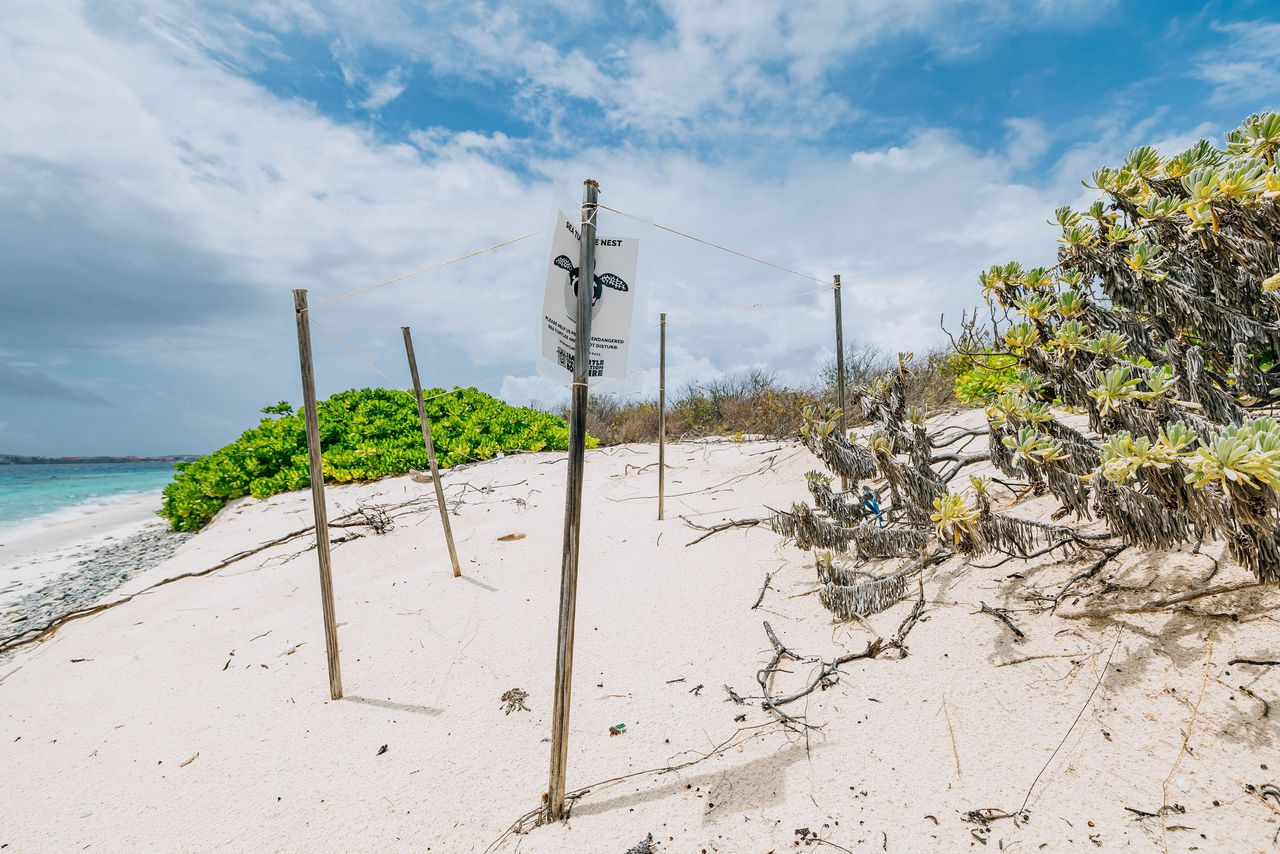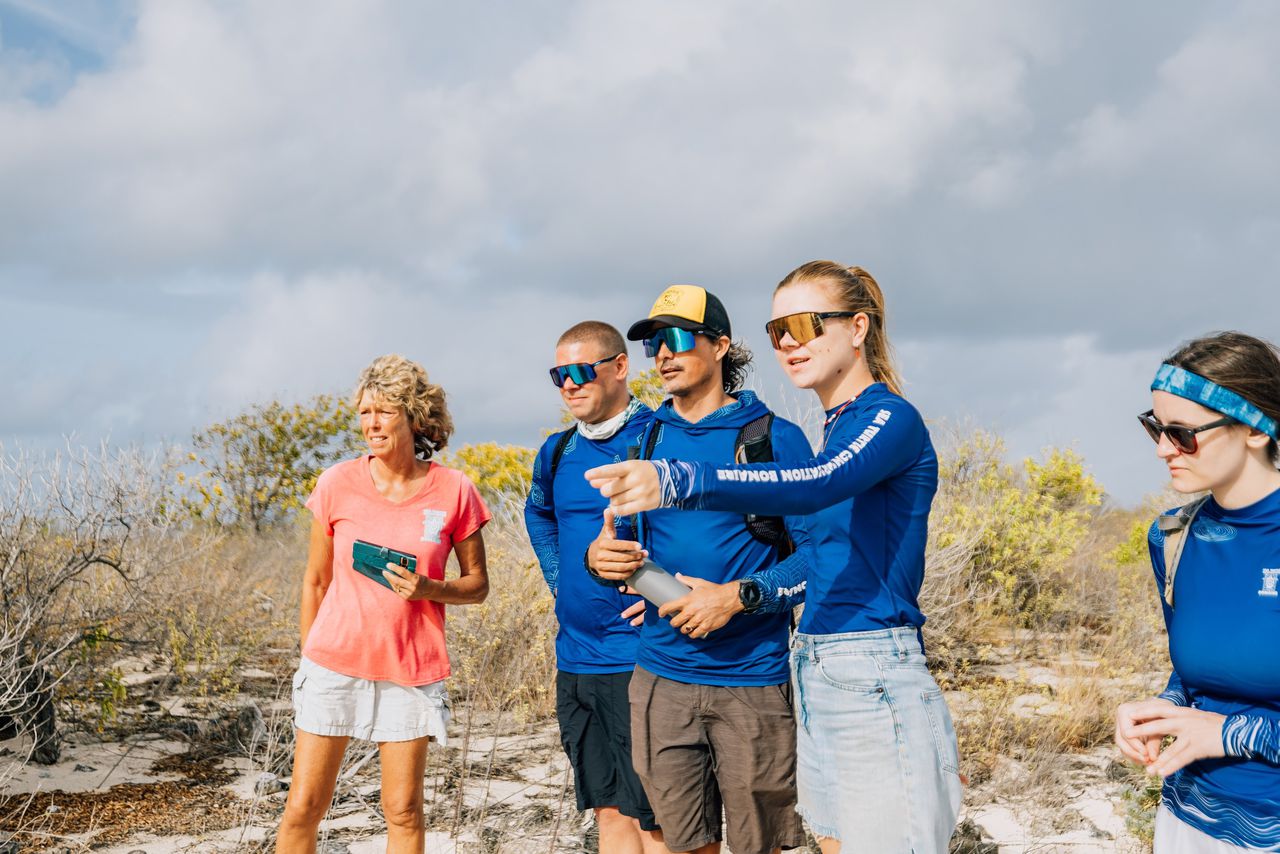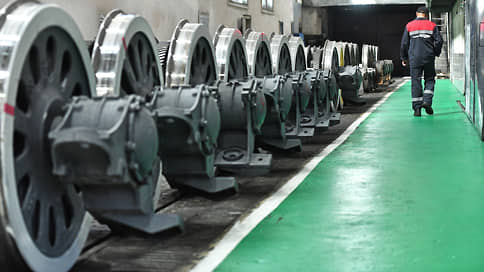Nest for Nest Watch of conservators on the beach of Bonaire over the survival of the sea turtle

« Do you see that, » Daan Zeegers asks, as he points to some traces in the white sand. It is good to look for the untrained eye, but waremple, it is stripes with wide slots that look like the back of an arrow. And that, Zeegers has previously explained what we came to look for at Klein Bonaire. Here is tonight.
But are eggs here too? Zeegers, field coordinator of Sea Turtle Conservation Bonaire, two interns and three volunteers stand around the tracks and consult. Female turtles follow a fixed pattern of coming on land. They walk up the beach, dig a pit to lay eggs, cover it and return to the sea. The group doubts. « The track is going around and several pits have been made, » says Zeegers. « Sometimes a turtle does not find a good place. This pattern can mean that she did not get rid of her eggs. »
Sea Turtle Conservation Bonaire (STCB) is a non-profit organization that has been committed to the protection of sea turtles on Bonaire and Klein Bonaire since 1991, the uninhabited island in front of the west coast. The organization is researching the population, comes to the rescue of stranded or wounded animals, provides information in schools and monitors nests on beaches during the nesting season, which runs from May to December.
During that period, volunteers walk down the beaches every morning, looking for fresh traces and new nests. On average, they find around a hundred nests on the island per season. At each nest they look for the upper eggs, after the coming out the eggs are counted and the location is recorded via triangulation: with ribbons in several places, STCB marks the place without specifying where the nest is located, to prevent poaching.
The eggs come out after fifty to sixty days. The young turtles dig themselves up and crawl, usually at night, towards the sea. STCB keeps track of how many eggs have come out, helps those left behind to the sea and collects so valuable data about the state of the population.
Sea turtles are under pressure worldwide, says researcher and oceans expert Nathalie Houtman, associated with the World Wildlife Fund. Six of the seven species are threatened with extinction. Three of them, the green sea turtle, the dikkop turtle and the karet turtle, occur on Bonaire and other parts of the Caribbean. The biggest threat is large -scale fishing, in which turtles become entangled in nets as a by -catch. They are also still struggling in countries where there is little or no regulations. Their shield, meat and eggs are still there.
In addition, natural habitats are rapidly disappearing due to tourism, (illegal) coastal development and (light) pollution. Turtles eat plastic, get entangled in waste or can no longer safely install their nests through human activity.
If it gets too hot, the turtles will be deformed or die
Climate change worsens all this. The rising sea level threatens breeding beaches, just like the increasing intensity of tropical storms. In addition, research shows, the temperature of a nest determines the gender of the young: warmer sand, from 31 degrees, mainly produces females, a colder nest of 26 degrees, especially males. The gender distribution is the same at 29 degrees. Warming causes disturbed relationships in the population, in some places the percentage of females rises to above 90 percent. If it gets too hot, the turtles will be deformed or die.
Worldwide organizations are committed to protecting sea turtles, says Houtman, who himself did research for months on turtles on Bonaire. So there are so -called hatcheries In the Caribbean, but also in parts of Asia, such as Malaysia and the coral triangle – safe breeding areas where eggs can come out in a controlled manner.
« This hatcheries Or breeding grounds are places where eggs are monitored, « says Houtman. » If the eggs are in danger, for example due to flooding or disturbance due to tropical storms, they are again buried in a safe environment or a higher area. » The goal is always to safely help as much boy as possible to the sea, with as little human intervention as possible.



Photos Flavio Maestroni
Action is also being taken at international level. The UN-OREANEN CONFERATION took place in Nice last week. The result is disappointing for many environmental organizations and scientists. Too few countries put their signature under a treaty to officially ratify the protection of international waters, not even the Netherlands. There will also be no EU requirements for turtle-friendly tropical shrimp fishing.
However, agreements have been made for protecting coral and other important habitats of sea turtles. And the so -called ‘blue corridors’ – safe migration routes – are not only for whales but also for sea turtles. These routes look closely at the behavior of sea turtles and their food and reproductive areas. DNA material is collected on more than four thousand breeding grounds in 147 countries.
Sea turtles play an important role in marine ecosystems. Green turtles keep the seagrass short, which contributes to the health of the seabed and erosion occurs. Karet turtles eat sponges, giving coral space to grow. Dikkop turtles and leather turtles regulate the jellyfish population, which would otherwise be able to eat large amounts of fish and larvae.
Where nest beaches are protected and human disruption is limited, you see quickly results. « On the Greek island of Zakynthos, protection of the nesting beaches and, for example, taking out night lighting led to record numbers of dikkop turtles. Newborn turtles orient themselves on the moonlight that reflects at sea – through artificial light they can become disoriented, with fatal consequences, » says Houtman.
After a short search and some digging in the sand, Zeegers concludes that the group can continue. « No nest here, » he says. Twenty meters away he stops again. A new track, with a clearly different pattern. Just before a small sand bed, the track stops. « We are going to dig here, » says Zeegers. « This female did not jump to the sea of course, there is a good chance that she has laid her eggs below. »
Our starting point is: leave the turtles and eggs alone as much as possible
Siffer four people carefully dig with their hands in the sand. Ten centimeters, twenty, thirty. If one of the volunteers comes across the first egg, cheers goes on. The first eggs are 36 centimeters depth, as large as ping -pong balls. They are from a karet turtle, one of the three species that occur on Bonaire. The other are the false caret turtle, or dick turtle, and the green turtle.
After a short inspection, Zeegers decides that this nest can be moved better. It is too close to the coastline, with a good chance that high water will reach the nest and the turtles have no chance of survival. Carefully, with gloves on, Zeegers digs out all the eggs. They should not be turned; Squedadembryos attach to the eggshell within a day and with too much movement they can come loose.
/s3/static.nrc.nl/wp-content/uploads/2025/06/17170425/data133806650-98f471.jpg)
He creates the sand between the eggs in the bucket to bring as many bacteria from the mother as possible. In a self -dug pit a little further, the 158 eggs are replaced, just as deep as in the old nest. « Our starting point is: leave the turtles and eggs alone as much as possible, » says Zeegers. « But in some cases it is better to intervene, to increase the chance of survival. »
Nests contain on average between one hundred and two hundred eggs. A female nest four to six times a season. That seems a lot, but only a very small percentage of the eggs grows into an adult turtle, estimates vary between one in a thousand and one in ten thousand. « That is sufficient for the survival of the species, » says Zeegers.
The sea turtle is doing well on Bonaire. The population seems, as far as STCB has a view of it. « Great of course, » says Zeegers, « but Bonaire is also a dot on the world map. We can monitor well here, but what happens to them when they swim the corner? No idea. »
/s3/static.nrc.nl/wp-content/uploads/2025/06/17170420/data133806628-ec5c4b.jpg)

:format(webp)/s3/static.nrc.nl/images/gn4/stripped/data133769201-f43dbe.jpg)
/s3/static.nrc.nl/wp-content/uploads/2025/06/17194032/web-1706BIN_arib.jpg)
/s3/static.nrc.nl/images/gn4/stripped/data133810079-22c32c.jpg|https://images.nrc.nl/Ri6XOVlJ66L5de1EbBNxhnUxtvg=/1920x/filters:no_upscale()/s3/static.nrc.nl/images/gn4/stripped/data133810079-22c32c.jpg|https://images.nrc.nl/F9AncUBAiXwtzERnH-RAGI2d9Yg=/5760x/filters:no_upscale()/s3/static.nrc.nl/images/gn4/stripped/data133810079-22c32c.jpg)




